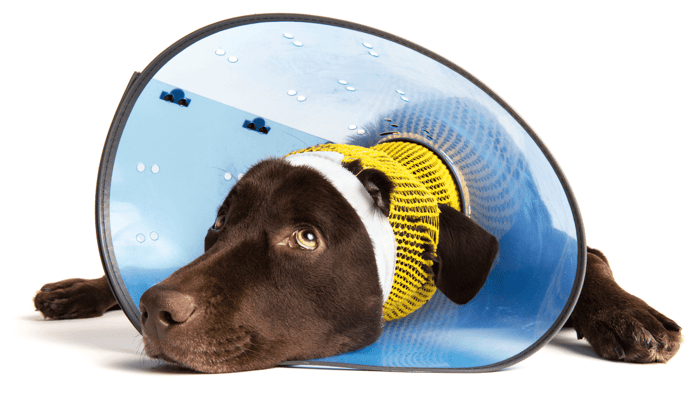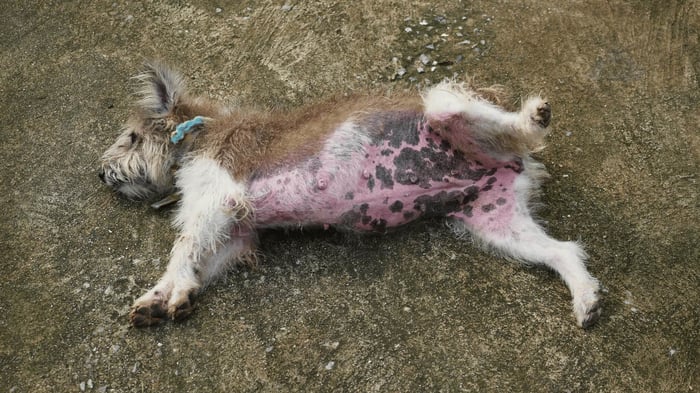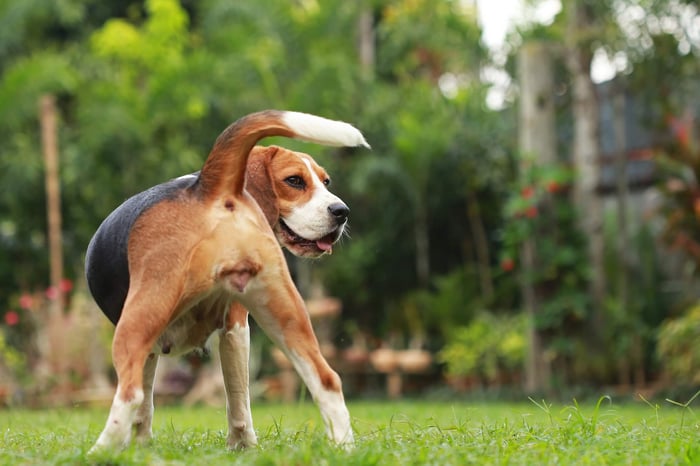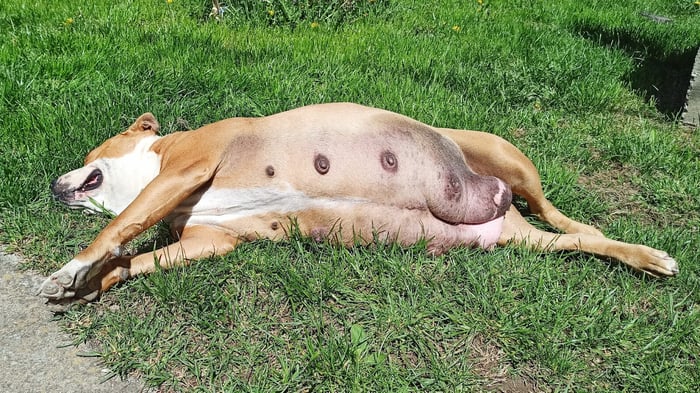After neutering and healing, the next thing on dog owners’ minds is when to take a cone off their dog. Personally, I hate that cone of shame. My dogs are miserable with it on, as they struggle to navigate the house, or eating and drinking. So, I’m always waiting to rip that cone off as soon as I can. Studies on the welfare implications of the “cone of shame” agree that cones are not good for a dog’s quality of life and we should use alternatives whenever we can.
First, it is critical to understand why the Elizabethan Collar or plastic cone is necessary in the first place. After neutering, dogs are at risk of licking or biting at the surgical site, which can cause infection and delay healing or damage the stitches. But let’s delve into when we can take that cone off and any alternatives.
Note: The technical name of the post-surgery cone dogs wear around their neck is the Elizabethan collar, which some shorten to e-collar or E-collar. But since an e-collar also refers to an electronic collar or shock collar, I won’t be using that term in this collar.
So, When Can I Take The Cone Off My Dog After Neutering?
After neutering, a dog will usually need to wear the plastic cone, (also called the Elizabethan Collar or cone of shame) for at least a week. The standard time for normal neutering is 7 to 10 days. However, if the surgery was more intensive, such as removing a retained testicle, they may need to wear the collar for up to 14 days.
There are also non-surgical neutering options, which means no stitches and no cone of shame!
Sometimes, your vet may recommend keeping the cone on longer if your dog licks or bites at the wound area. Conversely, if your dog is healing well and shows no signs of irritation or discomfort, your vet may recommend removing the cone earlier than the standard 10-14-day period.
It is also important to monitor your dog closely during the healing process. Contact your veterinarian immediately if you notice any signs of infection, stitches open but not bleeding, or irritation, such as redness, swelling, or discharge from the surgical site.
Understanding the Neutering Process
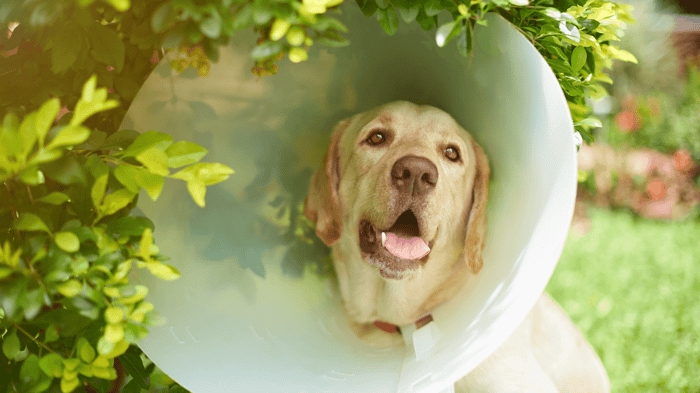
Neutering is a surgical procedure to eliminate the males’ ability to reproduce. Neutering your dog has benefits like preventing testosterone-triggered behavior like aggression and unwanted pregnancies. Personally, I neuter my dogs to keep them from roaming.
No matter what one does to secure your hard, a male dog can often find a way out if they smell a female dog in heat. And since I live in a very rural area, having my dogs roaming after a female in heat is just not not a risk I can take. Not only is there plenty of livestock in the area, but there are also plenty of trigger happy farmers, not to mention the risk of roaming male dogs getting injured, lost, or stolen.
So neutering is not negotiable to me and most dog owners.
Of course, some studies suggest that neutering your dog too early (under one year for large breeds) makes them susceptible to health issues like hip dysplasia, cranial cruciate ligament tears, and cancer. So many people, like myself, try to hold off on neutering as long as possible, until the dog is a full grown adult.
It will also pay to know what to expect after neutering your dog to be ahead of the surgical and healing process. It is also essential to note that neutering will not necessarily stop your dog from exhibiting sexual behavior like mounting or humping.
What Happens During Neuter Surgery?
The procedure is performed under general anesthesia, typically taking 30 minutes to an hour to complete. During the process, the veterinarian will make a small incision in the dog’s scrotum and remove the testicles. The incision is then closed with stitches, and the dog is monitored as he recovers from the anesthesia.
Why Dogs Need Cones After Neutering
After neutering, dogs are fitted with a cone, an Elizabethan collar. As we know, these collars affect your dog’s quality of life. However, as much as your dog will hate every single minute in the collar, it has its benefits.
The cone prevents the dog from licking or biting at the incision site, which can cause infection or delay healing. Even the most well-trained dog will want to scratch and lick on the incision site, which can damage the stitches or cause infection, since a dog’s tongue isn’t always clean. However, if the cone is a big problem for your dog after surgery, we will discuss alternatives to the Elizabethan collar below.
However, it’s important to keep the cone on the dog until the incision has fully healed, which can take up to two weeks. During this time, keeping the incision site clean and dry is essential, and monitoring the dog for any signs of infection or complications is necessary.
Signs Your Dog is Ready to Remove the Cone
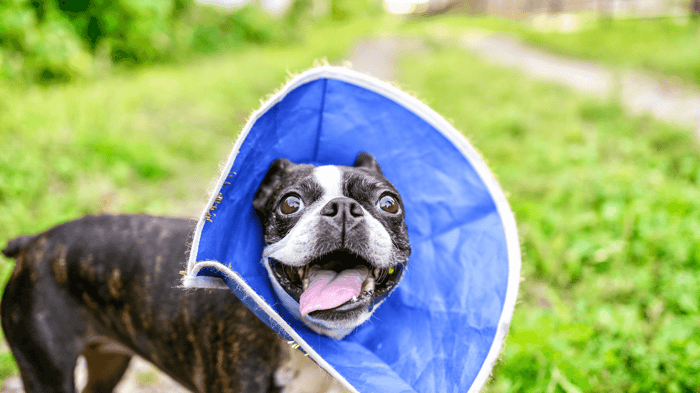
When a dog is neutered, wearing the cone of shame is expected to prevent them from bothering the incision site. However, it is crucial to know when it is safe to remove the cone to ensure proper healing and prevent any complications.
Here are some signs to look for to determine if your dog is ready to have the cone removed.
Healing Progress
One of the most important indicators that your dog is ready to have the cone removed is the progress of the incision site. The incision should heal well, with no signs of redness, swelling, or discharge.
The stitches or staples should be intact and not show any signs of loosening or coming apart. If the incision looks clean and dry, it is a good sign that your dog is healing correctly and may be ready to have the cone removed.
Behavioral Indications
Another important factor to consider is your dog’s behavior. If your dog seems comfortable and is not bothering the incision site, it may be a sign that they are ready to have the cone removed.
If your dog is not excessively licking or biting at the area, it may be safe to remove the cone. However, if your dog still shows discomfort or irritation, it may be best to wait a little longer before removing the cone.
What Should I Do if My Dog Won’t Keep a Cone on After Neuter Surgery?
A cone is usually recommended to prevent your dog from accessing the area. However, some dogs may refuse to wear the cone or find ways to remove it. Below we will also look at options you can use instead of cone to protect your dog while they recover.
If your dog doesn’t keep a cone on after neuter surgery, there are a few things you can do:
- Try a different cone type: Some dogs find the traditional plastic cone uncomfortable or restrictive. Alternative options, such as soft cones or inflatable collars, may be more comfortable for your dog.
- Use a T-shirt or onesie: If your dog won’t tolerate any type of cone, you can try using a T-shirt or onesie to cover the surgical site. Make sure it fits snugly but isn’t too tight, and monitor your dog closely to ensure they don’t chew or pull at the fabric.
- Increase supervision: If your dog won’t keep a cone on or wear a t-shirt, you may need to increase your charge. Keep your dog in a confined area or on a leash when you can’t watch them closely, and redirect their attention when they lick or bite the surgical site.
Keep your dog from jumping around and avoid challenging exercises to facilitate the healing process. If your dog continues to remove their cone or access the area, contact your veterinarian for further advice.
12 Alternatives To The Plastic Cone For Dogs After Neuter Surgery
Thankfully, there are some creative alternatives that can help your pup recover from their surgery without the need for the dreaded cone. In this article, we’ll explore a few of these alternatives and discuss how they can make the healing process more comfortable for your furry companion.
1. Soft Elizabethan Collars
One alternative to the traditional plastic cone is the soft E-collar, which is designed to provide protection without the discomfort. These collars are made from lightweight and flexible materials like fabric or foam, making them much more comfortable for your dog to wear. They still restrict access to the surgical area, preventing your pup from licking or scratching the incision site, but they do so without the rigid and cumbersome design of the plastic cone.
2. Inflatable Collars
Inflatable collars, often referred to as “donut” or “pillow” collars, are another excellent option for post-neutering recovery. These collars are essentially inflatable rings that fit around your dog’s neck, forming a barrier that prevents them from reaching the surgical site. Inflatable collars are comfortable to wear, lightweight, and allow your dog to maintain better peripheral vision and freedom of movement compared to traditional cones.
3. Recovery Suits
For a more comprehensive alternative, consider using a recovery suit. These one-piece garments cover your dog’s entire body, leaving only the head and paws exposed. Recovery suits are made from breathable, stretchy fabric and are designed to keep your pup from accessing the surgery site while allowing them to move around freely. Plus, they come in a variety of adorable designs, turning your dog into a fashionista during their recovery period.
4. DIY Solutions
If you’re feeling crafty, you can even create your own alternative to the plastic cone. Using soft, breathable materials like old t-shirts or bandages, you can fashion a custom-made protective cover for your dog’s surgical site. This approach allows you to tailor the garment to your dog’s specific needs and comfort.
5. Commercially Produced Visors
Some pet supply companies offer visors designed specifically for dogs. These visors shield the dog’s eyes and face, preventing them from reaching their surgical site without obstructing their peripheral vision too much. They are usually made from lightweight and comfortable materials.
6. Boots, Socks, and Leggings
Boots, socks, and leggings can be used to cover your dog’s paws and legs to prevent them from scratching the surgical area. Make sure they fit snugly and securely to ensure they stay in place.
7. Muzzles
A soft and comfortable muzzle can be an effective way to prevent your dog from licking or biting the surgical site. Ensure that the muzzle allows for proper ventilation and doesn’t cause discomfort. When a dog is properly trained to accept the muzzle, it can be less stressful than the cone. Just make sure the muzzle fits comfortably and doesn’t chafe anywhere.
8. Topical Bitterants
Topical bitter sprays or creams can be applied to the surgical area to deter your dog from licking or chewing it. These products have an unpleasant taste that discourages licking but is safe for your dog.
9. Customized Collar from a Pool Noodle
Get creative and make a customized collar using a pool noodle. Cut the noodle to the appropriate length, create a split to fit it around your dog’s neck, and secure it in place with tape or Velcro straps. This DIY option provides a cushioned barrier and can be a comfortable alternative.
10. Towels and Bandages
Wrap soft towels or bandages snugly around your dog’s neck to create a protective barrier. Be sure not to make them too tight to avoid discomfort, and change them if they become soiled.
11. Medication
Consult your veterinarian about the possibility of prescribing medication to reduce your dog’s urge to lick or scratch. This can be an effective way to prevent them from interfering with the surgical site.
12. Positive Reinforcement Training
Implement positive reinforcement training techniques to discourage your dog from bothering their surgical area. Reward good behavior with treats and praise, and redirect their attention when they try to lick or scratch.
Each dog is unique, so it may take some trial and error to find the most suitable alternative for your pet’s specific needs and comfort. Consult with your veterinarian for guidance on the best option to ensure a smooth and comfortable recovery after castration.
Steps to Safely Remove the Cone
Removing the cone from a dog after neutering is a crucial step in recovery. It is essential to follow the proper steps to ensure the dog’s safety and comfort. Here are the steps to safely remove the cone:
- Make sure the dog is calm and relaxed. Remove the cone when the dog is sleepy or resting is best.
- Gently lift the cone off the dog’s head. It is essential to be gentle and not pull or tug on the cone, as this can cause discomfort or injury to the dog.
- If the cone is stuck or difficult to remove, try using a small amount of lubricant around the edges of the cone to loosen it.
- Once the cone is removed, check the dog’s neck and ears for any signs of irritation or injury. If there is any redness, swelling, or wounds, consult a veterinarian for further treatment.
- Monitor the dog after removing the cone to ensure they do not lick or scratch the surgical site. If necessary, use a deterrent spray to keep off the site.
Following these steps, dog owners can safely remove the cone and ensure their pet’s comfort and well-being during recovery.
Post-Cone Care and Monitoring
Post-cone care and monitoring in dogs refers to the care and observation required after a dog has undergone a surgical procedure and is wearing an Elizabethan collar or “cone”. This is essential for preventing infection and ensuring proper healing.
Here are some guidelines for post-cone care and monitoring in dogs:
Observing for Complications
After a dog has been neutered, it is crucial to monitor them for any complications that may arise. If you notice any of the following symptoms, contact your veterinarian immediately:
- Redness or swelling around the incision site;
- Excessive bleeding or discharge;
- A foul odor coming from the incision site; or
- Lethargy or loss of appetite.
If you notice any signs of an allergic reaction, such as hives, difficulty breathing, or swelling of the face, seek veterinary care immediately. In some cases, dogs may be allergic to the sutures or the cone.
Promoting Further Healing
Once you remove the cone, you can take steps to promote further healing. First, ensure your dog is comfortable and has a quiet resting place. Avoid strenuous activity for at least 7-10 days after removing the cone.
You may need to clean the area with a mild soap and water or an antiseptic solution recommended by your veterinarian. Be sure to follow any instructions provided by your veterinarian for cleaning and caring for the incision site.
If your dog is experiencing discomfort, your veterinarian may recommend effective pain medication. Follow the dosage instructions carefully and monitor your dog for any adverse reactions. Encouraging your pup to sleep comes in handy as it helps in the formation of tissues.
Your dog should recover from the neutering surgery without complications with proper care and monitoring. However, contact your veterinarian immediately if you have concerns or notice any unusual symptoms.
Listen to Your Vet
Follow your veterinarian’s recommendations for feeding and dietary restrictions after surgery.
Limit playtime and exercise as your veterinarian advises, and encourage your dog to rest and avoid strenuous activity or jumping.
When to Consult a Vet
While most dogs recover well after neutering, keeping an eye on your furry friend during the healing process is important. If you notice any of the following symptoms, it’s best to consult a veterinarian:
- Excessive bleeding: Some bleeding is normal after surgery, but if it’s unreasonable or doesn’t stop after applying pressure, seek medical attention immediately.
- Swelling or discharge: If you notice swelling around the incision site, it could be a sign of infection.
- Lethargy or loss of appetite: If your dog seems unusually tired or doesn’t want to eat, it could be a sign of pain or discomfort.
- Persistent vomiting or diarrhea: These symptoms could indicate a reaction to medication or anesthesia.
It’s important to note that dogs are different; some may require more attention and care than others. Contact your veterinarian for advice if you need more clarification about your dog’s recovery. They can guide you on when to remove the cone and how to care for your dog during the healing process.
Are There Any Ways To Neuter Or Spay My Dog Without Surgery?
Let’s talk about non-surgical or non-invasive options for neutering dogs, which can be a convenient way to avoid the post-surgery wound care hassle.
- Chemical Neutering (Neutersol): Neutersol is an injectable chemical that sterilizes male dogs without the need for surgery. It’s a non-invasive option that involves a simple injection into the testicles. While this method eliminates the need for wound care, it’s essential to consult your veterinarian to see if it’s suitable for your dog’s age, size, and breed.
- Zeuterin (Zinc Neutering): Similar to Neutersol, Zeuterin is another chemical option that involves injecting a sterile solution of zinc gluconate into the testicles. This non-surgical method sterilizes male dogs effectively, and since it doesn’t require incisions, there’s no post-operative wound care to worry about.
- Hormonal Suppression: Some veterinarians may recommend hormonal suppression therapy for male dogs. This approach involves the use of medication to suppress testosterone production temporarily. While it’s not a permanent solution, it can be a practical option for owners who want to delay surgical neutering and avoid wound care altogether.
- Vasectomy: A vasectomy is a surgical procedure that sterilizes male dogs without removing their testicles. Unlike traditional neutering, which removes the testes, a vasectomy only blocks the vas deferens, preventing the transport of sperm. While this still involves surgery, it’s less invasive and eliminates the need for post-operative wound care around the scrotum.
- Tubal Ligation: For female dogs, tubal ligation is a non-invasive option that involves blocking the fallopian tubes to prevent pregnancy without removing the ovaries. Since there’s no incision in the abdominal area, you won’t have to worry about post-surgical wound care.
- Hysterectomy: Another non-invasive option for female dogs is a hysterectomy, which removes the uterus while leaving the ovaries intact. This procedure eliminates the risk of pregnancy without the need for wound care around the abdomen.
It’s essential to discuss these non-invasive options with your veterinarian to determine the most suitable choice for your dog based on their age, breed, and individual health considerations. While these methods can spare you the trouble of post-surgery wound care, it’s crucial to prioritize your pet’s overall well-being and consult with a veterinary professional to make an informed decision.
Frequently Asked Questions (FAQs)
How long does it take for a neuter incision to heal in dogs?
How long should a dog wear a cone after neutering?
Can I take the cone off my dog after seven days?
When can a dog stop wearing a cone after neuter surgery?
How do I know if my dog’s neuter incision has healed?
Conclusion
Waiting for the veterinarian’s instructions before removing the cone after neutering a dog is best. The cone is essential to prevent the dog from messing with the surgical area, leading to other complications.
The time frame for wearing the cone varies depending on the dog’s breed, age, and recovery rate. Keeping the cone on for at least ten days post-surgery is recommended. However, depending on their healing progress, some dogs may need to wear it longer.
In addition to the cone, the dog should follow a restricted activity regimen during recovery. This means no running, jumping, or playing for a few weeks until the surgical area has been restored. The dog can recover quickly and return to its routine with proper care.


